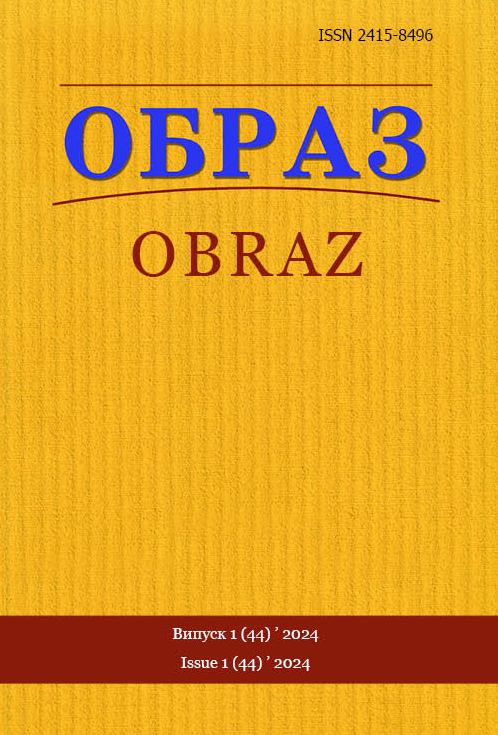Abstract
Introduction. The 1920s and the beginning of the 1930s forever entered the history of Ukraine as a period of incredible development of the cultural and artistic sphere. The rapid development of culture contributed to the spread of reporting, which helped readers to clearly, dynamically, in detail, and documentary accurately show a fragment of the life of that time.
Relevance and goal. The relevance of the research is determined by the fact that the genre-stylistic and thematic features of the reports of 1920−1930 are still under-researched and, therefore, require meticulous analysis.
The goal is to investigate the specifics of the creation of the image of Altai in the Ukrainian literary reportage on the travel theme «Altai» by V. Hzhytsky based on a comprehensive and detailed analysis.
Methodology. To study the outlined issue, general scientific methods of material selection and systematization, comparative analysis, bibliographical-descriptive, cultural-historical, and descriptive analytical methods, as well as the method of generalization were used.
The results. Volodymyr Hzytsky’s report «Altai», which he wrote after visiting the Oirot Autonomous Region in 1928, was thoroughly analyzed. The author chose a chronological type of composition, which allows him not only to describe events but also to share his impressions and thoughts from what he saw. V. Hzytsky tries to make his report as interesting as possible for the reader. That is why he talks in detail about the nature of Altai, the mentality, traditions, and culture of the local population. The language of the report is extremely simple, and informal. One gets the impression that the reporter is simply talking to his readers and conveying the necessary information to them.
Conclusions. Despite more than ninety years since it was written, V. Hzytsky’s literary report on the travel subject «Altai» is read with interest even today. V. Hzytsky’s observations are original, they do not repeat well-known truths – they are unexpected and always exciting. A vivid description of everything that the reporter saw, with his emotions, feelings, and impressions allows readers to feel the personal presence of the author, his «I». Thanks to the availability of a large amount of factual material, this report is especially valuable because it helps to feel the spirit of the era.
References
1. Avras, L., Itkis, P. & Shmatko, V. (1931),Altyn-Tau (Golden Mountains): a Trip to Distant Altai, Molodyj biljshovyk, Kharkiv-Odesa, 88 p.
2. Vaskiv, (2004), «Altai in the Ukrainian travel essay of the 1930s», Literaturnyj Proces: Metodologhija, Imena, Tendenciji. Filologhichni Nauky [Literary process: methodology, names, trends. Philological sciences], no. 3, pp. 89–94, available at: http://nbuv.gov.ua/UJRN/Litpro_2014_3_25.
3. Vovk, V. & Rusakov, V. (1932), In the Country of Altyn-Tau: Travel Essays, Ukrajinsjkyj robitnyk, Kharkiv, 117
4. Hzhytskyi, (1929), «Altai», Plugh [Plow], no. 9, pp. 44–59.
5. Hzhytskyi, (2011), «Memories of the past. Heritage», Literary source studies, textology, Instytut literatury im. T. Gh. Shevchenka NAN Ukrajiny, Laurus, Т. IV, Kyiv, 502 p.
6. Egart, (1932), Crossing. Altai Essays, DVU, Literatura i Mystectvo, Kharkiv-Kyiv, 172 p.
7. Melnyk, V. (1995), «Days and nights of Vasyl Gzytskyi», Word and Time [Slovo i Chas], 9–10, pp. 17–21.
8. Nytchenko, (1992), Letters of Writers, Vyd-vo «Lastivka», Melborn, 199 p.
9. Pavliv, (2015), Report: Between Facts and Emotions. A Practical Guide for Journalists, Vydavnyctvo Ukrajinsjkogho katolycjkogho universytetu, Lviv, 120 p.
10. In the Kazakh Altai: travel essays (1933), Vijsjkove vydavnyctvo «Na varti», 16 p.
11. Prykhodko, (1993), Creative Portraits of Ukrainian Writers of the 20th century: a guide for universities and schools, Podillja, Khmelnytsky, 160 p.
12. Sanovych, A. (1929), «Book of Facts», A New Generation [Nova Gheneracija], 3, pp. 56–62.
13. Slutskyi, (1939), «On Oiratia. Altai», Universe [Universe], no. 4, pp. 19.
14. Sobachko, O. (2006), «Ukrainian literary organizations and currents in the second half of the 20s of the 20th century», Scientific note of the Institute of Political and Ethnonational Studies named after I.F. Curas of the National Academy of Sciences of Ukraine [Naukovi zapysku Instytutu politychnykh ta etnonacionaljnykh doslidzhenj im. I.F. Kurasa NAN Ukrajiny], vol. 32. pp.257–
15. Tsymbal, (2016), «Flirting with Essay and Nonfiction», Paths under the sun. Report of the 20s, Tempora, Kyiv, pp. 5-18.
16. Shkliar, V. (1999), Theory and Methodology of Journalistic Creativity: lecture notes, MILP, Kyiv, 31 p.

This work is licensed under a Creative Commons Attribution 4.0 International License.

